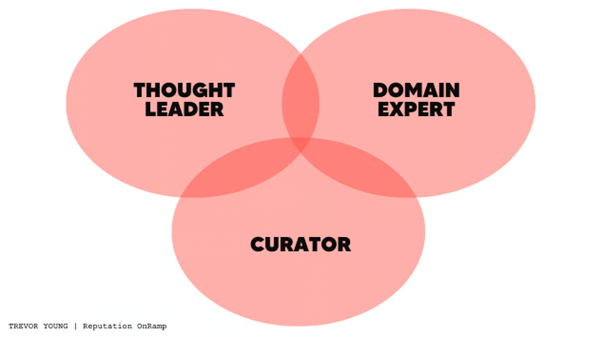We humans might think we have the whole communication schtick locked down, but there are some members of the animal kingdom that might teach us a thing or two.
Bees dance to communicate with their peers, birds connect through song, while ants use sensory touch to advise and communicate with the rest of the colony.
The list of how animals communicate is a fascinating rabbit* hole to stumble down.
It triggers thoughts of how downright cute their methods can be, to “wow, ‘where is David Attenborough and his film crew when you need them” territory, but the common thread is how each form of communication is unique to each species … and it works.
The same can be said for humans, of course, and how we all have different forms of communication.
One form of communication which needs examining is “thought leadership.”
Yes, I know it has become so overused that we have started to whisper the two words as if it’s a naughty term – but stay with me.
I’ve been working in the world of ahem, thought leadership, for almost a decade now.
I had this as a key tool in my toolkit when I was a communications manager for a large national organisation. My role was to promote 100 or so key consultants in the world of recruitment, HR, technology and modern workplaces.
I set up a system that created individual content marketing platforms for the key consultants who wanted to take part.
I used a combined recipe of owned and earned media – blogs, LinkedIn, partner-led research, opinion papers, videos and events with a strong sprinkling of earned media.
From landing OpEds in industry magazines to positioning the team in key national broadsheets to publishing large research or opinion pieces on our own content platform and their pimped-out LinkedIn pages, I was running an internal media agency and had hundreds of clients.
A common theme under all of it? Ding, ding, you nailed it…thought leadership.
Just like most business jargony terms, we have overused and loved the term “thought leadership” to death. THIS is why we can’t have nice things.
Its use has become as on the nose as the terms “deep dive”, “low-hanging fruit” and, worse yet, “content is king”.
Regardless, the principle and thinking behind thought leadership still has a place, a value, and when done right can provide results.
I’ve seen it happen countless times. From a client being headhunted for a global role because the company appreciated her online brand and what she would bring to the leadership role, to people getting offered opportunities proactively because their approach and thoughts had been noticed from afar, to my own personal journey of starting the agency almost nine years ago to now.
It’s just the branding of thought leadership that needs some work.
I was on a panel last week to talk about this subject and while I was trying to say every term other than “thought leadership” my fellow panelist John Knight just owned it.
He called it Thought Sharing. He said we are sharing our thoughts to show authentic leadership. It was simply a beautiful thought that showed incredible leadership.
Later in the week, I saw a very funny and poignant blog from the very clever Trevor Young. He said: “Lots of self-proclaimed ‘thought leaders’ talk a lot, but say little (and what they do say is often unoriginal and regurgitated from someone else).
“Just because you call yourself a thought leader, or an expert, doesn’t necessarily make you one.”
He outlined that to take ownership of your profile, you could be one of three things:
- A thought leader
- A thought curator
- A domain expert
He did a full Trevor Young mic drop.
He came prepared with his Macquarie Dictionary and even added a Venn diagram for good measure. As you can see below in Trevor’s graph, you can be a purebred of one of the three and you sometimes you can be a hybrid at times.
My favourite client is one we can easily position as a hybrid … in their communications plan we have a large percentage of them as domain experts or thought leaders and the filler is curated content to keep the ball in the air and to expand reach and network.

So why does this all matter?
Are you asking who cares? If it walks like a duck, quacks like a duck – it’s a peking duck pancake, Sarah.
Yes, and no.
Here are the key defined things I know and have learned along the way:
- Should everyone take control of their brand? Yes, why let anyone else tell your story.
- Should everyone do a digital audit of their brand? Yes, see answer to the above question.
- Should everyone be a thought leader? It depends, and this depends on the time and energy they want to commit to this and, quite crudely, if they have original thoughts.
- Should everyone be curating their brand? Absolutely. If you aren’t actively reading or learning every day, you are stale and not the best you can be.
- Should all leaders, professionals, founders and business owners look at their executive profile? Absolutely … but just like the animals they need to know which form of communications is for them.
I have some clients who are natural writers. They write regular blogs and OpEds, with our guidance.
Some are better as podcast guests or podcast presenters, and some are better at in-person event speaking.
Be like the bees and the ants and find out what your natural form of communication is and ensure you know exactly what your three key expert topics are.
More than three topics, you are an expert, you are a generalist.
As good ole Trevor says: “Having clarity matters because it affects how you’re positioned in the marketplace: the conversations you start online and/or the comments you make on other people’s posts, the events you present at, and the content you create – all of these activities are crucial as to how you can shape people’s perceptions, and influence how they see (and talk about) you.”
And before you ask, I’m a very opinionated domain expert who loves curating clever people (need proof – check out this blog).
*Rabbits communicate with each other through various methods, including body language, vocalisations, and scent marking.
If you’re ready to elevate your executive profile, contact Bespoken for support with controlling your narrative.



